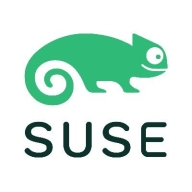SUSE Rancher manages and deploys Kubernetes clusters, simplifies container orchestration, and enhances DevOps practices, supporting multi-cloud environments and facilitating application scalability and monitoring.
SUSE Rancher provides robust Kubernetes cluster management and seamless integration with different tools and platforms, making it valuable for complex cloud infrastructures. It aids in automating workflows, ensuring consistent application performance across environments, and enhancing security with reliable RBAC. It simplifies operations with automated updates and comprehensive monitoring tools, supporting multiple Kubernetes distributions. SUSE Rancher offers centralized management of clusters with an intuitive experience, though it may benefit from better stability, performance optimizations, and improved documentation clarity.
What are the important features?
- Robust Kubernetes Cluster Management: Centralized management for multiple Kubernetes clusters.
- Seamless Integration: Smooth integration with different tools and platforms.
- Scalability: Facilitates application scalability across environments.
- Automated Updates: Simplifies operations with automated updates.
- Monitoring Tools: Comprehensive tools for monitoring clusters.
- Security: Enhanced security features with reliable RBAC.
- Extensive Documentation: Well-documented support and community resources.
What benefits and ROI should users look for?
- Improved Efficiency: Automates workflows, reducing manual tasks.
- Consistent Performance: Ensures consistent application performance across environments.
- Centralized Management: Simplifies the management of complex cloud infrastructures.
- Enhanced Security: Provides robust security with RBAC.
- Scalability: Supports scalable application deployments in multi-cloud environments.
SUSE Rancher is implemented in various industries where managing Kubernetes clusters and ensuring application scalability are critical. It supports complex cloud infrastructures, automating workflows, and integrating seamlessly with different tools, enhancing overall operational efficiency and security. In industries needing consistent performance and centralized management, SUSE Rancher proves to be an invaluable tool.
Tenable.io Container Security is a container security platform that delivers end-to-end visibility of Docker container images, providing vulnerability assessment, malware detection, and policy enforcement before and after deployment. It also integrates into your DevOps pipeline to eliminate security blind spots without slowing down software development. In addition, Tenable.io Container Security provides proactive visibility and security so your organization can solve the security challenges of containers at the speed of DevOps.
Tenable.io Container Security Features
Tenable.io Container Security has many valuable key features. Some of the most useful ones include:
-
Dashboard visibility: With Tenable.io Container Security, IT security managers gain at-a-glance visibility into container image inventory as well as security. Security teams can view vulnerability, malware, and other security data for all container images, and the distribution of vulnerabilities across images by CVSS score and risk level. The product also shows each image’s OS, OS version, and architecture.
-
Malware protection: The Tenable.io Container Security solution is unique because it is one of the only container security solutions that assesses container image source code for malware. It is designed with a custom-built malware detection engine to help ensure images are malware-free and to analyze container image source code.
-
Policy enforcement: If an image is created that exceeds the organization’s risk threshold, Tenable.io Container Security notifies developers immediately, with layer-specific information provided to help remediate issues rapidly. In addition, when using the solution, policy violations can trigger alerting or can optionally block specific images from being deployed. Policies can be applied globally or only to images in specific repositories.
-
Image syncing from third-party registries: The solution helps your organization gain instant insight into container security risks by synchronizing your existing registry images into Tenable.io Container Security. It integrates with Docker Registry, Docker Trusted Registry, JFrog Artifactory and Amazon EC2 Container Registry.
-
DevOps toolchain integration: In DevOps environments, Tenable.io Container Security can embed security testing into the software development tooling without blocking or disrupting existing software workflows or development processes.
Tenable.io Container Security Benefits
There are many benefits to implementing Tenable.io Container Security. Some of the biggest advantages the solution offers include:
-
Accurate, in-depth visibility: The platform helps you understand the individual layers of container images so you can gain an accurate view of cyber risk, reduce false positives, and provide detailed remediation guidance.
-
Securely accelerate DevOps: With Tenable.io Container Security, you can assess container images for vulnerabilities and malware as fast as 30 seconds from within the DevOps toolchain to avoid slowing down code velocity.
-
Enforce security policies: Tenable.io Container Security works to block new container builds that exceed your organizational risk thresholds to ensure containers are compliant with your security policies prior to deployment.
-
Decrease remediation costs: Tenable.io Container Security can help your organization dramatically reduce remediation costs by discovering and fixing software defects during development before application release.
-
Protect running containers: By implementing Tenable.io Container Security, you can gain visibility into running containers, which helps you to detect new vulnerabilities and security issues that may show up after deployment.



